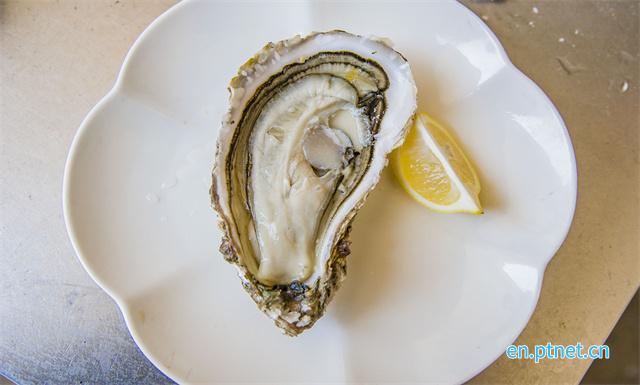Unravel the mysteries of oysters on Pingtan Island
en.ptnet.cn | Updated:2022-04-25 | Lin Kongbo, Stephanie
A boat loaded with oysters off the waters of Yutou Islet
Crabs, abalones, mussels, seaweed, and oysters are bounties of blessings from the ocean. Living off the sea has come naturally as part of survival and life on the island. Off the waters of Pingtan, somewhere in the west of Yutou Islet, part of the Haitan Archipelago, a bed of succulent oysters are finally out of its 3-year "confinement"!

Workers pictured harvesting oysters
The rage at the market
Massive blue buoys decorate the surface while cruising fishing boats form a fascinating landscape.
The waters gather an abundance of plankton and seaweeds due to the rushing current, which leads to rich nutrients for oysters - a prized gastronomic delicacy.

Rinse a piece of freshly-shucked oyster under the cool running water before sliding it down your throat. The luscious flesh mingling in salty seawater sends a tingle of bliss on the tip of the tongue. A hint of fresh cucumber scent immediately hits the nostril, leaving a lingering sweet aftertaste.

"These oysters have gone through a series of export tests set for the Australian market. It is safe for raw consumption." Yu Jingkang, deputy general manager of Fujian Anhe Aquatic Products Co., Ltd., told reporters that this is the "marine ranch" built by their company in Yutou. "The area is about 120 hectares. Unlike the traditional sticks-culturing, we use blue plastic ball "hangers," so oysters would always stay underwater and well-fed, no matter how the tides change," Yu Jingkang said.

Palm-sized oysters
After the harvest, the oysters were carried ashore. Workers sorted them by size, packed them into foam boxes, and transported them across the country.
“In the past, oysters were a staple commodity. The sales hinged on truck capacity.” Li Zuwei, sales director of the company said that the sales model not only limited the come, but also affected the brand establishment.
“The rise of the Internet has opened new sales channels. We are conducting commercial live-streaming. In this way, high-quality oysters are directly available to consumers.” Li told reporters that “Blue Oyster” is one of the brands built by their company. Oyster sales could hit about 15 million yuan this year.
“We are planning to build a resort that integrates aquaculture, sightseeing, and fishing and hold oyster-themed festivals,” Li added.

Workers on the shore pictured picking oysters from the harvest
Past and present on oyster shells
For seafood lovers, oysters are a delicacy that holds dear. They are also called “sea milk” and “sea ginseng.” Li Zunyun, an expert on the literature and history of Pingtan, the ancestors of Pingtan mastered the sticks culture technique as early as the Han Dynasty (202 BC – 220 AD).
Oysters were not only important marine economic crops at that time, but their shells also came in handy for many uses. In ancient times, people in Pingtan made wooden boats, and the gaps between the boards at the bottom of the boats would crack. Therefore, the wise fishermen created a bunder made from a mixture of shell ash and tung oil.
In the early Ming Dynasty (1368 to 1644 A.D.), oyster shells were calcined into lime. Lime and loess were mixed for building walls. The mixture is water-resistant and a natural insect-repellant, which makes it great for construction.
From the Qing Dynasty (A. D. 1644 to 1911) to the Republic of China (1912-1949), the shell ash industry was the third pillar industry, after the salt and fishery industries in Pingtan. From the 1960s to 1970s, relying on the continuous shell resources at Changjiang’ao Bay, shell ash output reached 1,000 tons annually, making them a far-reaching export to Southeast Asia, Hong Kong, and Taiwan.
Furthermore, old artists from Pingtan brought oyster shells to create. According to local annals, Pingtan established a local state-owned shell craft factory in August 1959 which began to produce shell paintings, and then gradually evolved into shell carvings. Since 1971, the artworks have made their way into Canton Fair. The artisans have created over five-hundred products in six categories, including circular engravure, relief carvings, shell-embedded lacquerware, shell-embedded antique furniture, etc. Among these works, "Clam Girl," a shell sculpture made of oyster shells, topped the national list. Nowadays, Pingtan Shell Carving, as a provincial intangible cultural heritage, is well-received by tourists.
From the all-purpose shell ash in ancient times to the contemporary art of shell carvings, shells have undergone amazing metamorphoses conjured by human wisdom.
Spotted a mistake or want to add something? All rights reserved. Do not reproduce our content without permission–you can contact us directly on our Facebook messenger or Twitter mailbox. Follow @pingtanchina (Facebook/Twitter)

 Fujian Public Security Registration Code: 35012802000271
Fujian Public Security Registration Code: 35012802000271